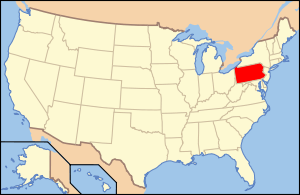Sonestown Covered Bridge
| Sonestown Covered Bridge | |
| Davidson Covered Bridge | |
| National Register of Historic Places | |
 The Sonestown Covered Bridge over Muncy Creek (west portal and north side) | |
| Official name: Sonestown Covered Bridge | |
| Named for: Village of Sonestown | |
| Country | United States |
|---|---|
| State | Pennsylvania |
| County | Sullivan |
| Township | Davidson |
| Road | TR 310 (single lane) |
| Crosses | Muncy Creek |
| Elevation | 933 ft (284 m) |
| Coordinates | 41°20′47″N 76°33′18″W / 41.34639°N 76.55500°WCoordinates: 41°20′47″N 76°33′18″W / 41.34639°N 76.55500°W [1] |
| Length | 110 ft (34 m) [2] |
| Width | 15.0 ft (4.6 m) [3] |
| Clearance | 10.0 ft (3 m) |
| Design | Burr Arch Truss Bridge |
| Material | Wood |
| Built | c. 1850 |
| - Repaired / restored | 1969, 1996, 2001, 2005, 2013 |
| Owned and Maintained by | Sullivan County |
| NBI Number | 000000000032095 [2] |
| WGCB Number | 38-57-03 [4] |
| Load | 3 tons (2.7 t) |
| Added to NRHP | July 24, 1980 |
| NRHP Ref# | 80003640 |
| MPS | Covered Bridges of Bradford, Sullivan and Lycoming Counties TR |
|
Location of the Sonestown Covered Bridge in Pennsylvania
| |
| Wikimedia Commons: Sonestown Covered Bridge | |
The Sonestown Covered Bridge is a Burr arch truss covered bridge over Muncy Creek in Davidson Township, Sullivan County, in the U.S. state of Pennsylvania. Built circa 1850, the bridge is 110 feet (34 m) long, and was placed on the National Register of Historic Places (NRHP) in 1980.[3] The bridge is named for the nearby unincorporated village of Sonestown in Davidson Township, and is also known as the Davidson Covered Bridge. It was built to provide access to a gristmill, which operated until the early 20th century.
Pennsylvania had the first covered bridge in the United States and the most such bridges in the 19th, 20th, and 21st centuries. In most places in the state they were a transition between stone and metal bridges, with the roof and sides protecting the wooden structure from weather. The Sonestown bridge is a Burr arch truss type, with a load-bearing arch sandwiching multiple vertical king posts, for strength and rigidity. The bridge construction is cruder than the other two surviving covered bridges in Sullivan County, with each Burr arch formed from six straight beams set at angles instead of a smooth curve.
The bridge was repaired circa 1969, and after flood damage in 1996, 2005, and 2013. It was also restored in 2001. Despite the repairs and restoration, as of 2012 the bridge structure's sufficiency rating on the National Bridge Inventory was only 19.0 percent and its condition was deemed "Structurally deficient" (the bridge was also closed in 2012, awaiting repair).[2][a] It is the shortest covered bridge in the county and as of 2015 is still in use, with average daily traffic of 50 vehicles in 2010.
Overview
The covered bridge crosses Muncy Creek in Davidson Township on Champion Hill Road (Township Road 310), just east of U.S. Route 220. The village of Sonestown is 1 mile (1.6 km) north of the bridge on Route 220 and has given the Sonestown Covered Bridge its name.[5] The bridge is also 1 mile (1.6 km) east of the village of Muncy Valley along Route 220.[6][7] Its official name on the NRHP is Sonestown Covered Bridge.[3][8] It is also known as the Davidson Covered Bridge, for its township.[6] Sullivan County is located in north central Pennsylvania, about 123 miles (198 km) northwest of Philadelphia and 195 miles (314 km) east-northeast of Pittsburgh.[9]

The area that became Davidson Township was first settled in 1806 and was incorporated as a township in 1833.[10] Within the township, George Sones built a sawmill and founded the unincorporated village of Sonestown in 1843.[6][11] All of these events occurred before Sullivan County was formed from part of Lycoming County on March 14, 1847.[10] The bridge was built in 1850, and in the late 19th century Sonestown "boomed like crazy"[12] as the lumber industry grew in Sullivan County. The village was then home to a plant that manufactured the staves for making barrels. It had a clothespin factory from 1903 to 1929 but lost almost all industry by the 1930s. As of 1996, Sonestown had a population of about 200, most of whom commuted to work in Muncy, Montoursville, and Williamsport. In 1996 the village had a few stores, an inn with a restaurant, and attracted tourists and hunters.[12]
History
Background
The first covered bridge in the United States was built in 1800 over the Schuylkill River in Philadelphia. According to Susan M. Zacher, author of The Covered Bridges of Pennsylvania: A Guide, the first covered bridges of the Burr arch truss design were also built in the state. Pennsylvania is estimated to have once had at least 1,500 covered bridges and is believed to have had the most in the country between 1830 and 1875.[13] In 2001, Pennsylvania had more surviving historic covered bridges than any other state, with 221 remaining in 40 of its 67 counties.[14]

Covered bridges were a transition between stone and metal bridges, the latter made of cast-iron or steel. In 19th-century Pennsylvania, lumber was an abundant resource for bridge construction,[13] but wood did not last long when exposed to the elements. The roof and enclosed sides of covered bridges protected the structural elements, allowing some of these bridges to survive for well over a century. A Burr arch truss consists of a load-bearing arch sandwiching multiple king posts, resulting in a stronger and more rigid structure than one made of either element alone.[14] Although there were 30 covered bridges in Sullivan County in 1890, only five were left by 1954, and as of 2015 only three remain: Forksville, Hillsgrove, and Sonestown.[3][15]
Construction and description
All three Sullivan County covered bridges were built in or circa 1850 with Burr arch trusses.[3][15] At the time of its construction, the Sonestown bridge was the fifth covered bridge in Sullivan County.[6] The bridge crossed Muncy Creek to provide access to Johnny Hazen's gristmill,[16] which was also built in 1850.[11] Although most sources do not list the builder of the Sonestown bridge, two newspaper articles on the remaining Sullivan County covered bridges reported that Sadler Rodgers had designed or possibly built it as well.[17][18] Rogers, a native of Forksville, built both the Forksville and Hillsgrove bridges in 1850, when he was 18 years old.[19]
On July 24, 1980, the Sonestown bridge was listed on the NRHP in a Multiple Property Submission of seven Covered Bridges of Bradford, Sullivan and Lycoming Counties.[13] The Sonestown bridge is also on the 2012 National Bridge Inventory (NBI), which lists the covered bridge as 110 feet (33.5 m) long, with a roadway 13 feet 6 inches (4.11 m) wide, and a maximum load of 5.0 short tons (4.5 t).[2] However, the maximum load posted beside the bridge itself is only 3.0 short tons (2.7 t). According to the NRHP, the bridge's "road surface width" is 15 feet (4.6 m),[3] which is only sufficient for a single lane of traffic.[2]
According to the NRHP form, the Sonestown bridge "is of lighter construction than similar bridges in south-eastern Pennsylvania".[3] The covered bridge rests on abutments of stone and mortar, which have been reinforced with concrete. The portals are flanked by wing walls below the level of the road;[5] these extend out from the abutments at an angle and "retain the soil of the approach embankment".[20]
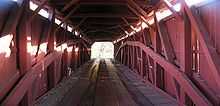
The bridge deck is made of wide boards laid perpendicular to the axis of the bridge, with two runners on top of the deck which run the length of the bridge.[5][16] The Burr arches which support the bridge are cruder than those in the other two Sullivan County covered bridges; they are not smooth "continuous arcs, but several straight segments joined at an angle".[3][5] The top of the Burr arch on the south (downstream) side of the bridge is noticeably lower than the top of the arch on the north (upstream) side.[21]
Vertical boards cover the sides and portals of the bridge and are painted red.[5] The bridge has a small window in the center of each side (it had no windows before the 2013 restoration), and openings between the eaves and the siding which run the length of the bridge on both sides. The gable roof is covered with wooden shake shingles. A sign listing the vertical clearance as 10 feet 0 inches (3.05 m) is posted above each portal. The bridge has no steel reinforcements.[5][16]
Attitudes towards covered bridges in Sullivan County changed considerably in the last half of the 20th century. Two of the five bridges that remained in 1954 were razed by 1970, when the Pennsylvania Department of Transportation considered tearing down the Forksville bridge (but renovated it because of its historic nature and appeal to tourists).[22] The Hillsgrove Covered Bridge was added to the NRHP in 1973, and the two other bridges were added in 1980. The Pennsylvania Historical and Museum Commission requires its approval for renovation work on NRHP bridges in the state, and forbids the destruction of these bridges.[23]
Use and restoration
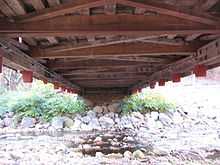
In the 19th century the Sonestown Covered Bridge survived major floods on March 1, 1865 and June 1, 1889, that destroyed other bridges in the West Branch Susquehanna River valley. The latter flood was caused by the same storm system that caused the Johnstown Flood, which killed over 2,200 people.[24] In 1885, the Williamsport and North Branch Railroad line along Muncy Creek reached Sonestown, passing just east of the bridge. The railroad carried lumber, coal, and passengers until it closed in 1938.[25]
The covered bridge was built to provide access to a gristmill,[16] and the 1915 state highway map of Sullivan County shows a mill just downstream of the bridge on the east bank of Muncy Creek.[26] The 1941 map (using data from 1939) no longer shows a water-powered mill there, although it does show two buildings on the east bank of the creek, with one just upstream and one just downstream of the bridge.[27] Both of these buildings had disappeared by 1999.[28] The NRHP form states that the bridge had been recently repaired in 1969, and that additional maintenance work was needed. The repairs done at that time included replacing some of the siding panels, reinforcing the abutments with concrete, and "very minor addition of steel to the truss structure".[3]
In January 1996, there was major flooding throughout Pennsylvania. A blizzard from January 6–8 produced up to 40 inches (100 cm) of snow, which was followed on January 19–21 by more than 3 inches (76 mm) of rain with temperatures as high as 62 °F (17 °C) and winds up to 38 miles per hour (61 km/h). The rain and snowmelt caused flooding throughout Pennsylvania, and ice jams made the flooding worse on many streams. In neighboring Lycoming County, flooding on Lycoming Creek in and near Williamsport killed six and caused millions of dollars in damage,[29] and an ice jam on Plunketts Creek destroyed a mid-19th century stone arch bridge which was also on the NRHP.[30]
The pressure of the flood on the Sonestown Covered Bridge moved the center of the structure almost 1 foot (0.30 m) downstream. This and other major damage closed the bridge from January until late December, 1996. It was one of 69 publicly owned bridges in Pennsylvania destroyed or closed by the flooding.[29] Sullivan County owns the bridge and paid for its repair, which was mandated by the state since it is listed on the NRHP. The original bid was for $93,000,[6] and the repair was done by Lycoming Supply Inc. of Williamsport for $89,000 over 60 days between mid-November and Christmas.[5][6] The bridge's closure caused a 5-mile (8 km) detour for those who normally used the bridge to reach their homes and businesses.[6]
Even after the repair was completed, vehicles that were heavier or larger than the bridge’s original limits could not use it. Since beer trucks could not cross it, deliveries to the American Legion Post southeast of the bridge were made with a hand cart instead.[31] On November 12, 2000, a new "Veterans Memorial Bridge" just downstream of the covered bridge was dedicated. The new bridge is also part of Champion Hill Road (Township Road 310), and allows all vehicles to cross Muncy Creek.[32][33]
According to NBI data, the covered bridge was restored in 2001.[2] In September 2004, flooding from Hurricane Ivan followed by heavy rains in April 2005 made a hole in one of the covered bridge's abutments and weakened a structural support. Repair work took six weeks and was done by mid-August 2005.[31] August of that same year saw placement of riprap and fill in the creek to further protect the abutments, with the work done by Rexer's Drilling and Concrete of Dushore for $9,250. Erosion in September 2004 had destroyed a house 200 feet (61 m) upstream of the bridge, so the Sullivan County Commissioners planned additional work to stabilize the creek bed and prevent further erosion damage. The work, on private property and requiring permission from the Pennsylvania Department of Environmental Protection,[34] was done in the summer of 2006.[35]
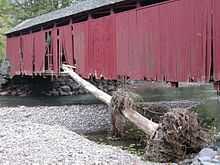
The NRHP form describes the bridge's condition as "fair" in 1969 and "good" in 1980.[3] Zacher's 1994 book and the Evans 2001 book also listed it as in "good" condition.[5][16] Despite this and the repairs and restoration, the 2006 Federal Highway Administration National Bridge Inventory found the sufficiency rating of the bridge structure to be only 18.6 percent.[b] It found that the bridge's foundations were stable for scour conditions (the potential for the stream washing them out), but that the railing "does not meet currently acceptable standards".[2] Its overall condition was deemed "basically intolerable requiring high priority of corrective action", with an estimated cost to improve the bridge of $108,000.[2]
In 1996 there was a tradition of decorating and lighting the Sonestown bridge for Christmas.[17] The average daily traffic on the bridge was 50 vehicles in 2006.[2] As of 2016, it was still used and was the only remaining covered bridge over Muncy Creek, although the Muncy Creek watershed also had the Lairdsville Covered Bridge, which spanned Little Muncy Creek in Lycoming County.[13] According to Zacher, the "Sullivan County bridges, because of their settings, are some of the most attractive in the state".[16]
The bridge was damaged when Muncy Creek flooded from over 12 inches (300 mm) of rainfall caused by Tropical Storm Lee on September 7, 2011.[36]
Dimensions
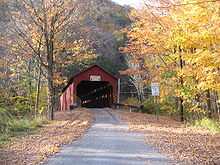
The following table is a comparison of published measurements of length, width and load recorded in different sources using different methods, as well as the name or names cited. The NBI measures bridge length between the "backwalls of abutments" or the pavement grooves at the opposite ends of the bridge.[2] It defines the roadway width as "the most restrictive minimum distance between curbs or rails".[2] The NRHP form was prepared by the Pennsylvania Historical and Museum Commission (PHMC), which surveyed county engineers, historical and covered bridge societies, and others for all the covered bridges in the commonwealth.[3][13] The Evans visited every covered bridge in Pennsylvania in 2001 and measured each bridge's length (portal to portal) and width (at the portal) for their book.[14] The data in Zacher's book was based on a 1991 survey of all covered bridges in Pennsylvania by the PHMC and the Pennsylvania Department of Transportation, aided by local government and private agencies.[16] The article uses primarily the NBI and NRHP data, as they are national programs.
| Length feet (m) |
Width feet (m) |
Load short tons (MT) |
Name used |
Source (Year) |
|---|---|---|---|---|
| 110 feet (33.5 m) | 13 feet 6 inches (4.11 m) | 5.0 short tons (4.5 t) | Sonestown | NBI (2012)[2] |
| 99 feet (30.2 m) | 15 feet (4.6 m) | 3.0 short tons (2.7 t) | Sonestown | NRHP (1980)[3] |
| 118 feet 9 inches (36.20 m) | 14 feet 6 inches (4.42 m) | NA | Sonestown | Evans (2001)[5] |
| 102 feet (31.1 m) | 15 feet (4.6 m) | NA | Sonestown | Zacher (1994)[16] |
See also
Notes
- a. ^ The National Bridge Inventory (NBI) is published each year in January by the National Highway Administration, using data submitted by state highway agencies which they collected during the preceding year.[37] The official NBI is published only in a machine-readable format, the only free, user-friendly version is at least a year out of date, so easily accessible NBI data is two or more years old.[38]
- b. ^ The National Highway Administration established the sufficiency rating, which can vary from a low of 0 to a high of 100, as a way to prioritize federal funding for bridges. The rating is calculated for bridges over 20 feet (6.1 m) long, based on "structural adequacy, whether the bridge is functionally obsolete, and level of service provided to the public".[39] Federal funds are available for replacement of bridges with a rating of 50 or below, while those with a rating of 80 or below qualify for rehabilitation.[40] In 2013, Pennsylvania had 22,659 bridges on the NBI, of which 42.2 percent were either structurally deficient (23.0 percent) or functionally obsolete (19.2 percent).[41]
References
- ↑ United States Geological Survey. "USGS Sonestown (PA) Topo Map". MSR Maps and the National Map. Retrieved 2008-06-07.
- ↑ 2.0 2.1 2.2 2.3 2.4 2.5 2.6 2.7 2.8 2.9 2.10 2.11 Federal Highway Administration National Bridge Inventory (2012). "State: PA, Place Name: Davidson (Township of), County: Sullivan, NBI Structure Number: 00000000003209". Nationalbridges.com (Alexander Svirsky). Note: this is a formatted scrape of the 2012 official website, which can be found here for Pennsylvania: "PA12.txt". Federal Highway Administration. 2012. Retrieved 2015-01-07.
- ↑ 3.0 3.1 3.2 3.3 3.4 3.5 3.6 3.7 3.8 3.9 3.10 3.11 "Pennsylvania Cultural Resources Geographic Information System" (Searchable database). Pennsylvania Historical and Museum Commission and Pennsylvania Department of Transportation. Retrieved 2015-01-07. Note: This includes Susan M. Zacher, Pennsylvania Historical and Museum Commission. "National Register of Historic Places Inventory Nomination Form: Sonestown Covered Bridge" (PDF). Retrieved 2015-01-07.
- ↑ Evans, Benjamin D.; Evans, June R. (1993). Pennsylvania's Covered Bridges: A Complete Guide (1st ed.). Pittsburgh, Pennsylvania: University of Pittsburgh Press. pp. 4, 255. ISBN 0-8229-5504-0.
- ↑ 5.0 5.1 5.2 5.3 5.4 5.5 5.6 5.7 5.8 Evans, Benjamin D.; Evans, June R. (2001). Pennsylvania's Covered Bridges: A Complete Guide (2nd ed.). Pittsburgh, Pennsylvania: University of Pittsburgh Press. p. 259. ISBN 0-8229-5764-7.
- ↑ 6.0 6.1 6.2 6.3 6.4 6.5 6.6 Moore, Catherine (1996-12-08). "Covered Bridge to Reopen". Williamsport Sun-Gazette. p. A3.
- ↑ 2014 General Highway Map Sullivan County Pennsylvania (Map). 1:65,000. Pennsylvania Department of Transportation, Bureau of Planning and Research, Geographic Information Division. Retrieved 2015-01-07.
- ↑ "NPS Focus". National Register of Historic Places. National Park Service. Retrieved 2013-06-05.
- ↑ Michels, Chris (1997). "Latitude/Longitude Distance Calculation". Northern Arizona University. Retrieved 2015-01-07.
- ↑ 10.0 10.1 "Sullivan County 8th class" (PDF). Pennsylvania Historical and Museum Commission. Retrieved 2015-01-07. Note: Davidson Township was formed in 1833 from part of Shrewsbury Township while both were still part of Lycoming County.
- ↑ 11.0 11.1 Ingham, Thomas J. (1899). History of Sullivan County, Pennsylvania: Compendium of Biography. Chicago, Illinois: Lewis Publishing Co. Retrieved 2015-01-07.
- ↑ 12.0 12.1 Moore, Catherine (1996-12-08). "People not alone in liking Sonestown". Williamsport Sun-Gazette. pp. A2–3.
- ↑ 13.0 13.1 13.2 13.3 13.4 Susan M. Zacher, Pennsylvania Historical and Museum Commission. "National Register of Historic Places Inventory Nomination Form: Covered Bridges of Bradford, Sullivan and Lycoming Counties" (PDF). Retrieved 2015-01-07.
- ↑ 14.0 14.1 14.2 Evans, Benjamin D.; Evans, June R. (2001). Pennsylvania's Covered Bridges: A Complete Guide (2nd ed.). Pittsburgh, Pennsylvania: University of Pittsburgh Press. pp. 2, 7, 12. ISBN 0-8229-5764-7.
- ↑ 15.0 15.1 Evans, Benjamin D.; Evans, June R. (2001). Pennsylvania's Covered Bridges: A Complete Guide (2nd ed.). Pittsburgh, Pennsylvania: University of Pittsburgh Press. pp. 257–259. ISBN 0-8229-5764-7.
- ↑ 16.0 16.1 16.2 16.3 16.4 16.5 16.6 16.7 Zacher, Susan M. (1994). The Covered Bridges of Pennsylvania: A Guide (2nd ed.). Harrisburg, Pennsylvania: Pennsylvania Historical and Museum Commission. ISBN 0-89271-054-3.
- ↑ 17.0 17.1 Eliot, Mollie (December 28, 1997). "Sullivan County's Covered Bridges Survive But Their Numbers Are Down From 30 to Three Today". Williamsport Sun-Gazette.
- ↑ Brokaw, Josh (March 11, 2012). "Last of the Covered Bridges: Sullivan County officials working to salvage 3 historic structures". Williamsport Sun-Gazette. pp. B1, B3.
- ↑ Sullivan County Industries: Now and Then. Endicott, New York: The Endicott Printing Company. 1954. Retrieved 2015-01-07.
- ↑ Pierce, Phillip C.; Brungraber, Robert L.; Lichtenstein, Abba; Sabol, Scott; Morrell, J.J.; Lebow, S.T. (April 2005). "Covered Bridge Manual: Publication No. FHWA-HRT-04-098" (PDF). US Department of Transportation, Federal Highway Administration, Turner-Fairbank Highway Research Center. p. 80. Retrieved 2015-01-07. Note: See page 80 and Figure 69 for more information on wing walls.
- ↑ Note: Follow this link for a photograph of the interior of the bridge with the south (downstream) side of the bridge on the right.
- ↑ "Covered Bridge at Forksville Being Renovated: Old Covered Bridge Just 'Oozing' History". Grit (City News Edition). 1970-09-13.
- ↑ Baumgartner, Nancy E. (1998-11-01). "Cogan House Covered Bridge Dedication Follows Facelift". Williamsport Sun-Gazette.
- ↑ Meginness, John Franklin (1892). "Chapter XIX. Internal Improvements.". History of Lycoming County, Pennsylvania: including its aboriginal history; the colonial and revolutionary periods; early settlement and subsequent growth; organization and civil administration; the legal and medical professions; internal improvement; past and present history of Williamsport; manufacturing and lumber interests; religious, educational, and social development; geology and agriculture; military record; sketches of boroughs, townships, and villages; portraits and biographies of pioneers and representative citizens, etc. etc. (1st ed.). Chicago, IL: Brown, Runk & Co. ISBN 0-7884-0428-8. Retrieved 2015-01-07. Note: ISBN refers to the Heritage Books July 1996 reprint. URL is to a scan of the 1892 version with some OCR typos.
- ↑ Taber, Thomas Townsend, III (1969). Muncy Valley Lifeline: The Life and Times of the Williamsport and North Branch and Eagles Mere Railroads. Muncy Valley Historical Society.
- ↑ Map of the Public Roads in Sullivan County, Pennsylvania (Map). Cartography by Ralph C. Benedict and Gustave P. Strum, State Highway Department. Pennsylvania Department of Transportation. May 1, 1915. Retrieved 2015-01-07.
- ↑ General Highway Map Sullivan County Pennsylvania (Map). Cartography by Pennsylvania Department of Highways in cooperation with the Public Roads Administration Federal Works Agency. Pennsylvania Department of Transportation. 1941 [Culture Features as of 1939]. Retrieved 2015-01-07.
- ↑ United States Geological Survey (1999-04-10). "The National Map, 226 km W of New York, New York, United States" (aerial photograph). MSR Maps and the National Map. Retrieved 2008-11-23.
- ↑ 29.0 29.1 Thompson, R.E., Jr. (1996-04-10). "Statewide Floods in Pennsylvania, January 1996". United States Geological Survey. Retrieved 2015-01-07.
- ↑ Scherkoske, Deborah A. (August 1996). "Plunkett's Creek Bridge No. 3, Spanning Plunkett's Creek at State Route 1005, Barbours vicinity, Lycoming County, PA". Historic American Engineering Record and Library of Congress. Retrieved 2015-01-07.
- ↑ 31.0 31.1 Maroney, Mark (2005-06-26). "Bridges under repair. Effort Underway to Save Historic Landmark in Sonestown". Williamsport Sun-Gazette. p. B1.
- ↑ Eliot, Mollie (2000-11-13). "Veterans Memorial Bridge Dedicated in Sonestown". Williamsport Sun-Gazette. p. B1. Note: this article incorrectly identifies the bridge as crossing Loyalsock Creek
- ↑ See this photo of the bridge's date plaque. The new bridge first appeared on the official Sullivan County Highway map in 2002: General Highway Map Sullivan County Pennsylvania (Map). 1:65,000. Cartography by Pennsylvania Department of Transportation Bureau of Planning and Research Geographic Information Division. Pennsylvania Department of Transportation. 2002. Retrieved 2015-01-07.
- ↑ Loewenstein, James (2005-07-05). "Sonestown Covered Bridge threatened by erosion". Towanda Daily Review.
- ↑ "Stream Stabilization Projects Completed in County: Sonestown Covered Bridge Site Reworked" (PDF). Sullivan County Conservation District. Fall 2007. p. 4. Archived from the original on 2009-03-26. Retrieved 2015-01-04.
- ↑ Eric Deabill. "Sonestown Cleans Up From Flash Flooding". WBRE. Retrieved 2011-09-14.
- ↑ "Recording and Coding Guide for the Structure Inventory and Appraisal of the Nation's Bridges" (PDF). Department of Transportation, Federal Highway Administration, Office of Engineering Bridge Division. December 1995. Retrieved 2015-01-04.
- ↑ Coby Logen (2007-08-06). "Navigating the National Bridge Inventory". dotgovwatch.com. Retrieved 2015-01-04.
- ↑ "Bridge Inspection Definitions". Virginia Department of Transportation. Retrieved 2015-01-05.
- ↑ "Bridge Sufficiency Ratings" (PDF). Kansas Department of Transportation. Retrieved 2015-01-05.
- ↑ "Bridges by State and County: Tables of Frequently Requested NBI Information". United States Department of Transportation, Federal Highway Administration. 2014-04-25. Retrieved 2015-01-04.
External links
| Wikimedia Commons has media related to Sonestown Covered Bridge. |
- Pierce, Phillip C.; Brungraber, Robert L.; Lichtenstein, Abba; Sabol, Scott; Morrell, J.J.; Lebow, S.T. (April 2005). "Covered Bridge Manual: Publication No. FHWA-HRT-04-098" (PDF). US Department of Transportation, Federal Highway Administration, Turner-Fairbank Highway Research Center. Retrieved 2015-01-07.
| |||||||||||||||||||||||||

